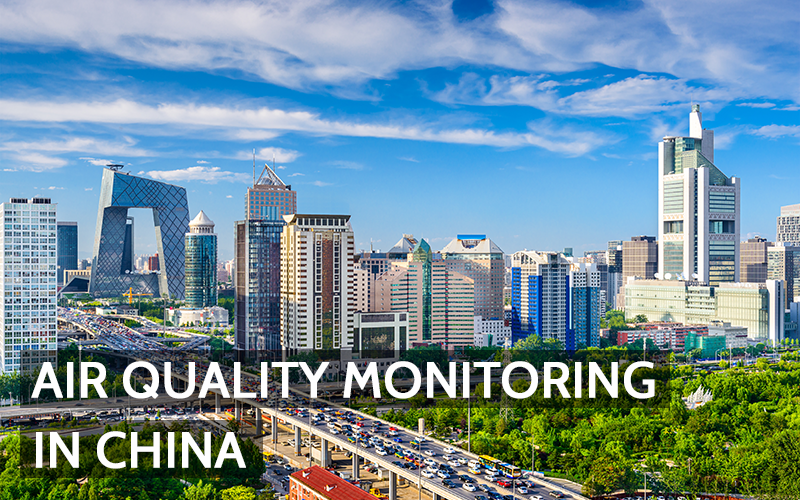Air quality has been a significant concern in China, particularly since the rapid industrialization that began in the late 20th century. The Chinese government, in collaboration with the private sector, has implemented various initiatives to monitor and improve air quality across the country. This article explores these initiatives, identifies the primary sources of air pollution, and outlines China’s goals and future plans for enhancing air quality nationwide.
Government Initiatives in Air Quality Monitoring
Recognizing the detrimental effects of air pollution on public health and the environment, the Chinese government has established comprehensive air quality monitoring systems. In 2013, the Ministry of Environmental Protection (now the Ministry of Ecology and Environment) launched a nationwide air quality monitoring network, deploying over 1,500 monitoring stations across 338 cities. These stations measure key pollutants, including particulate matter (PM2.5 and PM10), sulfur dioxide (SO₂), nitrogen dioxide (NO₂), carbon monoxide (CO), and ozone (O₃). The data collected is publicly accessible, promoting transparency and enabling citizens to stay informed about local air quality levels.
To enhance data accuracy and enforcement, China has integrated advanced technologies into its monitoring systems. The implementation of automatic monitoring equipment has significantly improved the quality of pollution data reported, reducing the likelihood of data manipulation by local officials. This technological advancement has been crucial in ensuring reliable data for policy-making and public awareness1.
Private Sector Contributions
The private sector has played a pivotal role in augmenting air quality monitoring efforts. Companies specializing in environmental technology have developed portable air quality monitors and mobile applications that provide real-time pollution data to users. These tools empower individuals to make informed decisions about their activities based on current air quality conditions.
Additionally, non-governmental organizations (NGOs) have contributed by creating platforms that compile and analyze pollution data. For instance, the Institute of Public & Environmental Affairs (IPE) developed the China Pollution Map Database, which aggregates environmental supervision records from government departments. This publicly available resource allows stakeholders to be informed and promotes societal supervision of corporate and regional environmental performance.
Primary Causes of Air Pollution
China’s air pollution stems from several sources:
- Industrial Emissions: Heavy industries, such as steel, cement, and chemical manufacturing, emit significant amounts of pollutants, including sulfur dioxide and nitrogen oxides. These industries have been central to China’s economic growth but have also contributed substantially to air quality degradation.
- Coal Combustion: Coal has been a dominant energy source in China, used extensively in power generation and industrial processes. The combustion of coal releases large quantities of particulate matter and greenhouse gases, making it a major contributor to air pollution.
- Vehicle Emissions: The rapid increase in vehicle ownership has led to higher emissions of nitrogen oxides and volatile organic compounds, which are precursors to ground-level ozone and smog. Urban areas, in particular, experience elevated pollution levels due to vehicular emissions.
- Biomass Burning: In rural regions, the burning of biomass for cooking and heating contributes to particulate matter pollution. This practice not only affects outdoor air quality but also poses indoor health risks.
Goals and Future Plans for Air Quality Improvement
The Chinese government has set ambitious targets to improve air quality. In December 2023, the State Council published an action plan aiming to achieve bluer skies by 2025. The plan includes measures such as promoting green industrial shifts, building a cleaner energy mix, and developing a low-carbon transport system. These initiatives are part of China’s broader commitment to peak carbon emissions before 2030 and achieve carbon neutrality by 20602.
To reduce reliance on coal, China is investing heavily in renewable energy sources. The country has become a global leader in the installation of solar and wind power projects, reaching its 2030 target for installed capacity years ahead of schedule. This shift towards renewables is expected to significantly reduce emissions from the energy sector3.
In the transportation sector, China is promoting the adoption of electric vehicles (EVs). Subsidies and incentives have been introduced to encourage consumers to purchase EVs, and investments are being made to expand charging infrastructure. These efforts aim to decrease emissions from traditional gasoline and diesel vehicles.
Furthermore, the government is enhancing regulatory frameworks to enforce stricter emission standards for industries and vehicles. Continuous monitoring and public reporting of air quality data are being emphasized to ensure accountability and transparency.
China’s approach to air quality monitoring and improvement is multifaceted, involving both government-led initiatives and private sector contributions. While significant progress has been made in reducing pollution levels, challenges remain due to the country’s industrial structure and energy consumption patterns. However, with continued commitment to policy implementation, technological innovation, and public engagement, China is poised to make further advancements in its quest for cleaner air and a healthier environment.
Related Articles:
Air Quality Monitoring in the United Kingdom: An Overview
Air Quality Monitoring in Brazil: Gov Initiatives and Future Plans
References:
- https://epic.uchicago.edu/news/study-finds-automatic-monitors-significantly-improve-the-quality-of-pollution-data-reported-in-china/
- https://english.www.gov.cn/policies/latestreleases/202312/08/content_WS65724f25c6d0868f4e8e1fcb.html
- https://www.ft.com/content/4afdd319-230f-4763-8107-d8a43308dcfc
- https://voxdev.org/topic/energy-environment/how-new-monitoring-systems-shaped-chinas-war-air-pollution
- https://link.springer.com/article/10.1007/s11783-024-1828-z
- https://www.cfr.org/blog/chinas-battle-against-air-pollution-update


